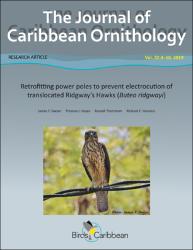Retrofitting power poles to prevent electrocution of translocated Ridgway’s Hawks (Buteo ridgwayi)
| License | This is an Open Access article distributed under the terms of the Creative Commons Attribution License, which permits unrestricted use, distribution, and reproduction in any medium, provided the original work is properly cited. | es |
| Author | Dwyer, James F. | |
| Author | Hayes, Thomas I. | |
| Author | Thorstrom, Russell | |
| Author | Harness, Richard E. | |
| Accessioned date | 2024-01-19T00:01:48Z | |
| Available date | 2024-01-19T00:01:48Z | |
| Year | 2019 | |
| Citation | Dwyer, J. F., Hayes, T. I., Thorstrom, R., & Harness, R. E. (2019). Retrofitting power poles to prevent electrocution of translocated Ridgway’s Hawks (Buteo ridgwayi). Journal of Caribbean Ornithology, 32, 4-10. Recuperado de: | es |
| URI | https://bvearmb.do/handle/123456789/3911 | |
| Abstract | Abstract: A translocation program for Critically Endangered Ridgway’s Hawks (Buteo ridgwayi) in the Dominican Republic initially met with limited success because hawks were being electrocuted on power poles around the translocation site. Many poles are now retrofitted and electrocutions have been drastically reduced. However, some electrocutions continue to occur. To understand why, we examined 150 retrofitted poles around the reintroduction site. We found 96 (64%) were retrofitted correctly. The remaining poles included mitigation plan errors, application errors, and improvisation errors, either singly or in combination. | es |
| Abstract | Resumen: Modernización de antenas eléctricas para evitar la electrocución de individuos translocados de Gavilán de La Española (Buteo ridgwayi)—El programa de translocación para Gavilán de La Española (Buteo ridgwayi), En Peligro Crítico en la República Dominicana, tuvo un éxito limitado inicialmente porque los halcones estaban siendo electrocutados en las antenas eléctricas alrededor del sitio de translocación. Muchas de estas antenas están ahora reacondicionadas y las electrocuciones se han reducido drásticamente. Sin embargo, continúan ocurriendo algunas. Para entender por qué, examinamos 150 postes modernizados alrededor del sitio de reintroducción. Encontramos que 96 (64%) se modernizaron correctamente. Los restantes incluían errores del plan de mitigación, errores de instalación y errores de improvisación, ya sea individualmente o combinados. | es |
| Abstract | Résumé: Équipement des poteaux électriques pour empêcher l’électrocution des Buses de Ridgway (Buteo ridgwayi) ayant été transférées—Un programme de transfert de Buses de Ridgway (Buteo ridgwayi), une espèce En danger critique d’extinction en République dominicaine, a d’abord connu un succès limité, car les buses s’électrocutaient sur les poteaux électriques autour du site de transfert. De nombreux poteaux sont maintenant équipés et les électrocutions ont été considérablement réduites. Cependant, des électrocutions continuent de se produire. Pour comprendre pourquoi, nous avons examiné 150 poteaux équipés autour du site de réintroduction. Nous avons trouvé que 96 (64 %) poteaux avaient été correctement équipés. Les poteaux restants présentaient des erreurs du plan d’atténuation, d’installation ou d’autres types, isolément ou en combinaison. | es |
| Language | English | es |
| Published | Journal of Caribbean Ornithology, 32, 4-10 | es |
| Rights | © 2019 Dwyer et al; licensee BirdsCaribbean. | es |
| Rights URI | http://creativecommons.org/licenses/by/3.0/ | es |
| Subject | Biodiversidad - República Dominicana | es |
| Subject | Aves ─ República Dominicana | es |
| Subject | Hábitats y especies | es |
| Subject | Especies amenazadas o en peligro de extinción | es |
| Title | Retrofitting power poles to prevent electrocution of translocated Ridgway’s Hawks (Buteo ridgwayi) | es |
| dc.identifier.doi | https://doi.org/10.55431/jco.2019.32.4-10 | |
| Material type | Article | es |
| Type of content | Scientific research | es |
| Access | Open | es |
| Audience | Technicians, professionals and scientists | es |
Files in this item
This item appears in the following Collection(s)
-
Investigación ambiental [1759]
Access and downloading this document are subject to this license: This is an Open Access article distributed under the terms of the Creative Commons Attribution License, which permits unrestricted use, distribution, and reproduction in any medium, provided the original work is properly cited.
© 2019 Dwyer et al; licensee BirdsCaribbean.
© 2019 Dwyer et al; licensee BirdsCaribbean.


